On September 1, 1939 in Stockholm, tickets for premiere screenings of films were sold on the trunk in Rigoletto - the American film Fury directed by Fritz Lang with Sylvia Sydney and Spencer Tracy in the main roles was screened, in Dramaten the autumn repertoire was launched with the premiere screening of the play Golden Wedding .
But there was anxiety in the air. The biggest traffic was in grocery stores, where Stockholmers bought food, especially coffee. The balconies along the Norr Mälerstrand promenade had been turned into pantries, so the aroma of beans was more distinct than the smell of the sea.
Sweden and the outbreak of World War II
At the same time, the Swedish government sat in Kanslihuset on Mynttorget under the chairmanship of Per Albin Hansson, who, according to the daily Social-Demokraten, "looked as calm as usual." The Defense Minister Per Edvin Sköld was of course also present. This afternoon, key decisions for the country were made: Sweden is to remain neutral , an extraordinary government meeting will be held next Friday, the combat readiness should be increased and gasoline rationing introduced. Many compared the situation then with that of the First World War, when Sweden also remained outside the conflict. It was mentioned:of course, life was difficult - there was a shortage of milk, eggs, bread, butter. It's going to be tough now, too, but we'll survive this time too.
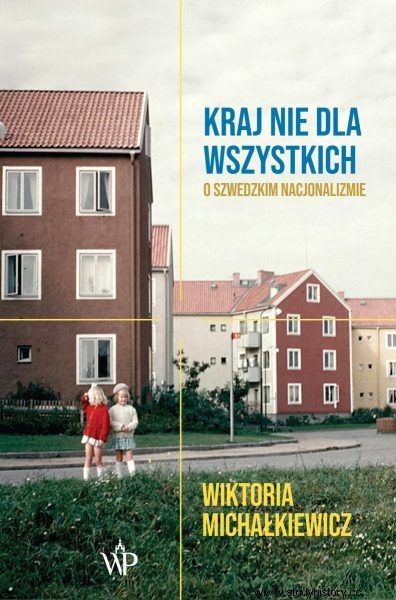
The article is an excerpt from the book Country not for everyone. About Swedish nationalism , which has just been released on the market under the patronage of Historical Curiosities
In a similar vein, Per Albin Hansson spoke to the nation from radio speakers. The priority was to "keep the country out of the war, nurture and protect inalienable national values," which could only be done in a community. Solidarity and responsibility - these two pillars were to ensure Sweden's security. From journalists and opinion leaders, the prime minister expected exceptional responsibility and common sense in exercising the privilege of freedom of speech . As decided by the government, tens of thousands of men were mobilized and could be called upon to serve in the uniform of the Crown at any time.
Immigrants?
Solidarity towards fellow citizens meant living even closer with what was one's own and safe - and separating what was foreign. This was especially true of immigrants. So far, they have not been a problem, there have only been isolated cases of lost wanderers. Thanks to the meticulousness of Swedish officials, we know when the first Jew and the first Catholic appeared in Sweden since the Reformation - because they had to obtain a special permit to enter the country.
When Finland broke away from Sweden in 1809, the country became practically mono-ethnic and one-faith. Even then, some groups were not welcome. This concerned the Gypsies, who were banned from immigration to Sweden in 1914. The law was in force until 1954, ten years after the end of World War II. The Law on Foreigners of 1927 itself was strongly influenced by the theory of race biology - it was intended to protect workers from foreign competition and help maintain the purity of the Swedish people. The government document reads:
The fact that the population of our country is exceptionally homogeneous is an invaluable value. Therefore, one should control the influx of representatives of other peoples who should not interfere with our people.
This view was shared by the diplomat Folke Malmar, who in October 1938 warned against the dangers of Sweden's overly generous policy:
After the initial friendly reception of Jewish newcomers, dictated by compassion for the exiles from another country and pride in the shelter offered, a feeling of discomfort began to increase, then overwhelming resentment, and finally stage four:the drama of slander, persecution, and even bloodshed, escape of the persecuted to other countries where these problems have never been observed or have been forgotten.
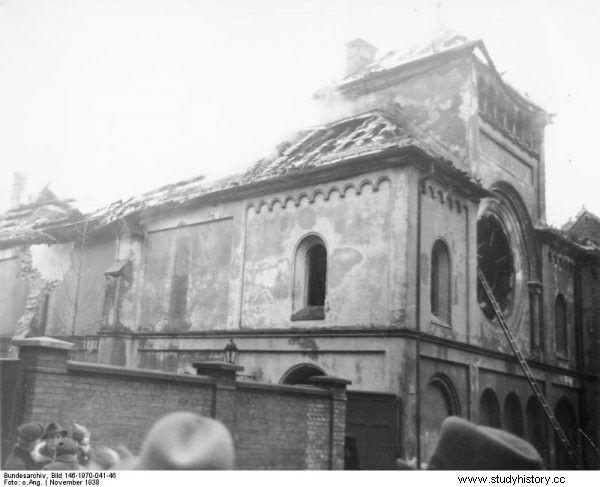
Burnt synagogue in Munich. Kristallnacht
The same year saw the events of "Kristallnacht" - the mass persecution of German Jews. Nevertheless, Sweden did not change the passport requirements, according to which the documents of persons of Jewish origin were to be clearly stamped with the letter "J" - to make it easier to identify them. Social Democrats proposed relaxing the migration law, but met with resistance, especially from students and trade unions. In the spring of 1939, students from the universities of Lund and Uppsala demanded that the influx of Jews to Sweden be stopped. The Swedish Association of Small Entrepreneurs joined the appeal. The discussion at Lund University was about the question of whether to allow ten German doctors of Jewish origin to settle in Sweden. Students were of the opinion that foreigners would take their jobs away.
Even the outbreak of the war did not change this attitude.
The situation of the Jewish population
On September 1, 1939, 16 Jews were expelled from the country as they tried to cross the Estonian-Swedish border. They were spotted by the crew of the Estonian border control vessel. They were detained and interned on the island of Utö. The refugees were not admitted to the country because the newcomers, according to the daily "Dagens Nyheter", had no right to set foot on Swedish soil without "satisfactory documents, and it would be best if they went to" the next beach where they are welcomed ".
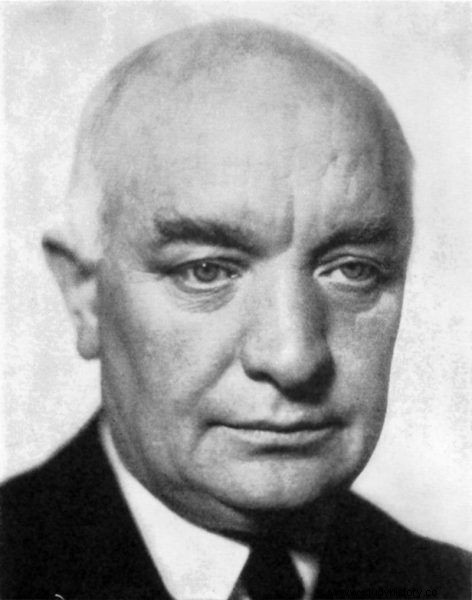
Per Albin Hansson
The assessment of the situation was appropriate under the applicable law, and the refugees - 14 men, a woman and a child - were sent back to Estonia, where they were arrested and sent for another transport to Lithuania. Probably few people reading the newspaper that day noticed the note about the expulsion of some Jewish refugees , dealing with the really pressing matters that writer Astrid Lindgren described in her diary:“When I went to my coffee dealer and wanted to buy a specific quarter of a kilo, I came across a sign on the door:Closed. Coffee exhausted ”.
There is no information about the situation of the Jewish community in any Swedish daily that has survived in the memories of Alfred Laufer, a nurse from Łódź. In 1945, Alfreda received refugee status in Sweden and stayed in a sanatorium in the town of Spenshult, which was temporarily converted into a center for immigrants. If she had come to Sweden before the war, her passport would have a clearly visible stamp with the letter "J" - like "jude".
Memories of Alfred
I experienced the terrible period of the German invasion in Łódź and in the Łódź ghetto, and I would like to briefly describe my and my brothers' experiences. Immediately after entering Łódź, the Germans decided to exterminate ["isolate" - they wrote in a pen] Jews from the rest of the population, were ordered to wear Jewish signs:at first, yellow bands were 10 cm wide, later changed to patches in the shape of the Star of David ; also yellow in color, which were sewn on each garment in a visible place on the chest and on the back. All Jewish apartments were also marked with the Star of David. This had its purpose:Jews were "caught to work". (...) Every German or German had the right to "catch". (…)
A harsh winter has come, and with it a decree celebrating the concentration of all Jews in the northern district of the city, unpaved, mostly built-up with sunken wooden houses and not lit with electricity everywhere. The city had to be "judenrein" [meaning "cleansed of Jews"] by March. Whoever had not moved to the ghetto by then was evacuated by force, accompanied by accurate shots. And so began a hard fight for a roof over my head. Fight - 160,000 people were to live where there were more than 40,000. 1.5 square meters were allocated per person, so 10 people were accommodated in small, sunken rooms. (…)
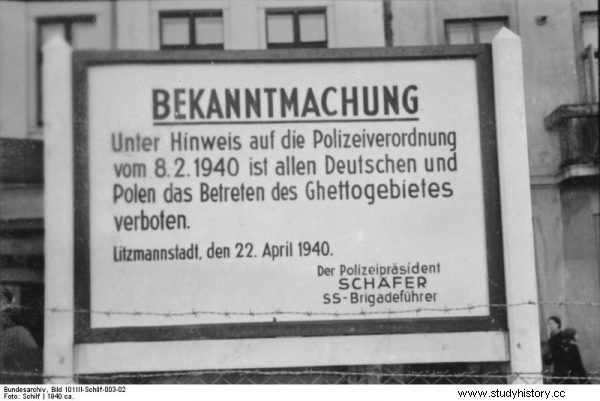
Plaque with information about the creation of the ghetto and the prohibition of unauthorized access to its area. Similar boards were densely placed along the entire ghetto fence.
The inhabitants of the ghetto faced the sad reality. Diseases spread at an alarming rate. Typhus and typhoid and spotted fever decimated the population, there were no conditions for the slightest observance of hygiene. Water was scarce, soap was hard to come by, the minimum amount of fuel was:1 kg of wood and 7 kg of briquettes per month. It is not known whether to use it to boil water [for] food or to heat yourself some washing water, so that lice, this disgusting and spreading plague, would not be so troublesome. (…)
The expulsions were (...) a separate chapter in the life of the ghetto and perhaps the most tragic one. Although the deportation sites were always a great unknown to us, they nevertheless hung over the ghetto like the sword of Damocles. We had no contact with the outside world, was punishable by death for reading newspapers or listening to the radio; There were even a few accidents of hanging in front of the public and the family of the guilty party. We knew nothing about the existence of Auschwitz or the other destruction camps. The individuals who risked their lives may have known it, but the general public did not know the truth. However, the fact was that there was no news "from there", and most painfully - families were ruthlessly torn apart. Children were taken from mothers, husbands from wives, women from husbands and children. (…)
It was September 1, 1942 - the third anniversary of the war. I worked as a nurse in the hospital at ul. Łagiewnicka. At that time, 430–440 sick people were lying there with their children; in addition, there was a children's hospital - about 200 beds - tuberculosis and mental diseases:200-300, infectious diseases 200, preventorium about 100.
5 a.m., cars, large, trucks, tightly covered with tarpaulins pull up in front of all hospitals. Car service is Rollkommando, a commando of destruction. Dressed in impregnated coveralls, rubber gloves and face masks. Their task is to ensure that absolutely all patients are loaded onto the cars. In case of disobedience, threatened with death. Hospital staff had to load cars. I cannot describe the panic among the sick when they found out what was going on. Among all experiences, even personal ones, the memory of the despair of the sick impresses me the most. Who can describe the gaze begging for life, shaking hands gathering their things. I found out then how strong the call to life can be. (…) There was fear in their eyes, their bodies, tired with their disease, chased away with the last of their strength. In the children's hospital, children were thrown out of the windows and they fled to their homes in panic. The children were released from the sanctuary through the back door, and the torturers found the building empty. (…)
Swedish press
The events witnessed by the Łódź nurse, Alfred Laufer, escaped the attention of the Swedish public. After a brief anxiety, the Swedes slowly resumed their daily activities. From the very beginning of the war, classes at school were held as usual. After the holidays, the children learned Swedish geography with renewed energy, punched in the multiplication table, and practiced needlework and gymnastics. The war was fun:at number 119 on Birgerjarlsgatan, several little ones were bombarding the street from the fourth floor with nets filled with water thrown from the balcony - luckily, no casualties.
Adults showed a bit more interest - on the bestseller list, the leading positions were occupied by "war" positions: Step by step Winston Churchill, 10 million children Eriki Mann (a novel that is a critical description of Nazi educational methods), and at the end of the podium: Can Germany win? Ivan Lajos, who doubted the affirmative answer to the question posed in the title of the book.
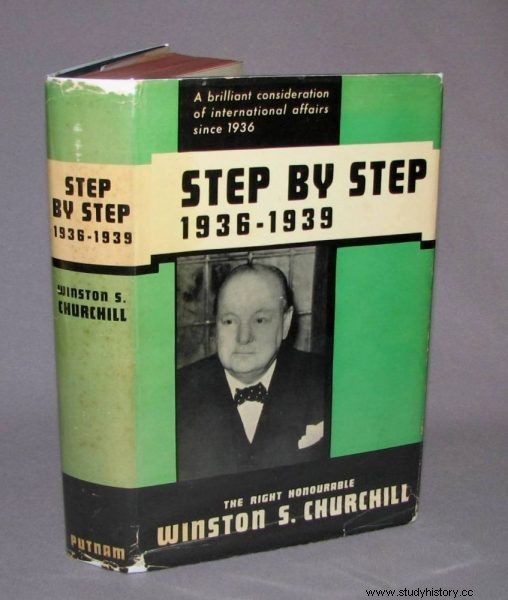
One of the most popular books in Sweden was "Step by Step" by Winston Churchill
In September Most Swedish newspapers did not write about the persecution of the Jews at all - only brief notes appeared. Some written in an optimistic (or ironic) tone, such as the one published in "Svenska Dagbladet" on January 17, 1940 under the title Germany in Warsaw protected against typhus:
The front tram cars in Warsaw will be reserved for Germans - soldiers and civilians - while the seats for Poles and Jews will be allocated separately. The ordinance is motivated by the fear of typhus and spotted fever that prevail in Warsaw and the fact that these diseases are transmitted by lice on clothes. For this reason, driving a tram in the same car as Poles and Jews poses a health risk to the Germans.
The newspaper added that although Warsaw trams have a small number of carriages, "it should not be a big obstacle for the Germans, who will have to stand during the journey" . Others gave dry facts, such as in a few-sentence note published on November 3, 1941 in "Dagens Nyheter" under the factual title of The death penalty for a Jew leaving the ghetto :
The General Governor of Kraków, Frank, issued an ordinance according to which Jews are forbidden to leave the created ghetto without permission, under penalty of death. The same punishment will befall those who knowingly try to hide such “refugees”. Trials will be held in special courts.
Control over public opinion
Equally important was control over public opinion and strengthening the feeling of loyalty to the country. Editorial offices received
"gray cards" with a list of topics that could be described and those that should be kept silent. Among other things, journalists were to avoid "sarcasm, harmful phrases and innuendo".
In the spring of 1940, dozens of publications were confiscated. Usually the reason was criticism of Hitler. A week after Sweden adopted the possibility of press censorship, Justice Minister Karl Gustaf Westman emphasized in a speech to the First Chamber of Parliament that citizens must not treat the war as a "discussion club". Günther agreed with him, who argued that the Swedish press should refrain from criticizing the "process of change" taking place in Europe. After all, Per Albin Hansson, despite all doubts about the existence of censorship in a democratic society, agreed with his ministers that it was better to keep society away from "such complex topics".
And things were extremely complicated.
At the beginning of the war, part of the Swedish army admired the successes of the Germans - their efficiency, competence and courage with which the army occupied the entire continent in just a few months. The officers therefore accepted the invitation of the German army to visit Berlin, during which the German side could boast of strategic successes.
When the Germans explained the effectiveness of the Blitzkrieg to the Swedes, representatives of the Swedish army decided to wear more discreet field caps so as not to be too conspicuous. The shorter the sun shone over Sweden, the greater the fear of war was - especially when neighboring Finland fought the Soviet offensive in the winter of 1939, and the Germans attacked Norway on April 9, 1940.
A change of front?
In June 1940, the Norwegian army surrendered, and King Håkon VII and the heir to the throne Olof, along with government representatives, sought refuge in London. At the same time, Sweden allowed the German army to travel through its territory - trains transporting German officers traveled mainly at night in order not to arouse anxiety among the population. It was only as a result of a break in the streak of German successes at the turn of 1942 and 1943 that the Swedish government slowly changed its course towards the pro-Western direction.

The article is an excerpt from the book A Country Not for Everyone. About Swedish nationalism, which has just been released on the market under the patronage of Historical Trivia
In the fall of 1944, Sweden severed its trade relations with Germany. At the same time, it became necessary to improve icy relations with neighbors. Per Albin Hansson has been involved in training the Norwegian and Danish police forces in Sweden. It was he who was directly offered to come to the aid of the Scandinavian countries. His Danish counterpart, who was Prime Minister Wilhelm Buhl, informed Hansson in November 1943 that, if absolutely necessary, Denmark would request military assistance, and in March 1945 mentioned the possibility of petitioning for Swedish military assistance to help maintain the row in Denmark. The priority was to keep the balance in the immediate surroundings.
"Why was nothing done?" - wondered at the same time Anna Jachnina, a social worker from Warsaw, who came to Sweden as a refugee and was in the asylum in Vrigstad.
The article is an excerpt from the book Country not for everyone. About Swedish nationalism, which has just been released on the market under the patronage of Historical Curiosities by Wydawnictwo Poznańskie
